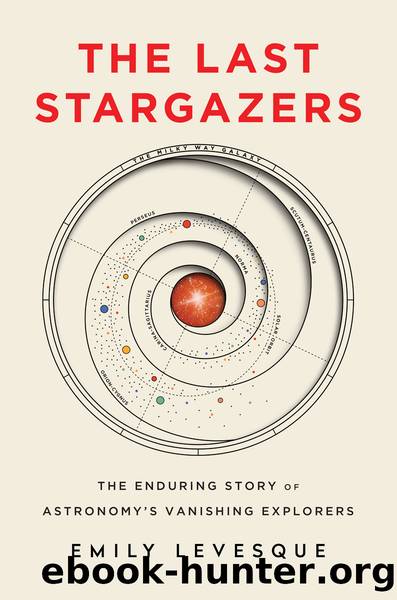The Last Stargazers by Emily Levesque

Author:Emily Levesque
Language: eng
Format: epub, mobi
Publisher: Sourcebooks
Published: 2020-08-15T00:00:00+00:00
The Very Large Array in New Mexico (in its photogenic “D” configuration). Credit: Alex Savello, NRAO/AUI/NSF.
First, though, I had a few of my own. As part of my summer research program, my fellow students and I would get the opportunity to propose for observing time on the VLA. A few hours of telescope time had been specifically set aside for our use, and I wanted to use it to study a few red supergiants. I knew that these stars could shed mass from their outer layers and that this mass would hang around, enshrouding the star in a sort of dusty shell as it cooled and dissipated. Apparently, the dust shell could sometimes produce something called a maser, stimulating and amplifying the emission of radio light at very bright and very specific wavelengths from molecules in the dust, but the detailed physics behind how this worked was still a mystery. I was curious as to whether we could explain how the masers formed and whether this could tell us anything about how the stars were dying, and with access to a radio telescope, I finally had the chance to observe these stars myself. We had the whole summer ahead of us to learn about how radio telescopes worked, but I wanted to get a head start. Plus, I’d used optical telescopes before thanks to my work with Phil Massey, and I’d taken Jim Elliot’s observing class. How different could radio telescopes be, really?
One of the on-site astronomers had agreed to chat with me, and I started out by asking a few questions about what they were currently observing, figuring that’d be a good start.
“What are you observing?”
“Well, right now, we’re on a phase calibrator for water near a protostar.”
Hmm. I tilted my head a little bit and nodded like this made sense.
“Mmm…how bright is it?”
“About four Kelvin.”
I…what? Kelvin was a unit of temperature, not how bright something was. My head tipped a little more.
“Er…how’s the observing going?”
“Well, the receiver is centered at minus thirty kilometers per second, but if the protostar is less than a millijansky per beam…”
This was starting to feel like an Abbott and Costello skit; I was fairly sure that I’d heard all these words before but had no idea they could be put together in this order. The angle of my head had listed past “thoughtful head tilt” and was rapidly approaching “confused schnauzer.” My comprehension level wasn’t faring any better.
The observer happily continued to chat about his science. We were both astronomers, but the terminology whizzing around felt like I’d stepped into a different field entirely. I hung on as best I could but felt a little bit of dread settling in my stomach. How different was this research, just because we were working at longer wavelengths? Very, apparently. (Happily, by the end of the summer, after ten weeks of research and a radio-astronomy-for-schnauzers crash course, I’d be chattering away with the rest of them.)
“We’re actually just about to switch targets and go to…” The
Download
This site does not store any files on its server. We only index and link to content provided by other sites. Please contact the content providers to delete copyright contents if any and email us, we'll remove relevant links or contents immediately.
| Aeronautics & Astronautics | Astronomy |
| Astrophysics & Space Science | Comets, Meteors & Asteroids |
| Cosmology | Mars |
| Solar System | Star-Gazing |
| Telescopes | UFOs |
Turbulence by E. J. Noyes(7037)
Tools of Titans by Timothy Ferriss(6945)
Astrophysics for People in a Hurry by Neil DeGrasse Tyson(4619)
Room 212 by Kate Stewart(4105)
Pale Blue Dot by Carl Sagan(4001)
The David Icke Guide to the Global Conspiracy (and how to end it) by David Icke(3881)
Secrets of Antigravity Propulsion: Tesla, UFOs, and Classified Aerospace Technology by Ph.D. Paul A. Laviolette(3445)
Apollo 8 by Jeffrey Kluger(3199)
Losing the Nobel Prize by Brian Keating(3187)
A Journey Through Divination and Astronomy by Publishing Pottermore(3059)
Goodbye Paradise(2958)
COSMOS by Carl Sagan(2950)
Brief Answers to the Big Questions by Stephen Hawking(2876)
How to Read Water: Clues and Patterns from Puddles to the Sea (Natural Navigation) by Tristan Gooley(2853)
The Five People You Meet in Heaven by Mitch Albom(2841)
The Order of Time by Carlo Rovelli(2714)
How to Read Nature by Tristan Gooley(2664)
A Brief History of Time by Stephen Hawking(2473)
Aliens by Jim Al-Khalili(2382)
